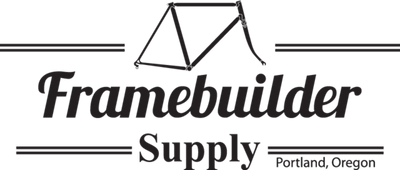Glossary
Frame building is the art and science of constructing the bicycle frame: that collection of tubes to which you attach wheels, cranks, handlebars, and much more. Frames are constructed in a variety of ways, including, but not limited to, brazing, welding, gluing, and lay-up.
See a decent overview of materials and their pros/cons here.
Alloy - Strictly speaking, an alloy is a mixture of metals. There are aluminum, steel, and titanium alloys. It's worth noting, though, that within the bike industry there is a tendency to refer to aluminum parts as alloy. We're not sure why this is; perhaps it's a translation thing. Regardless why, take care to make sure that what you are about it buy is what you want to buy. This is also a good time to mention that for all practical purposes you cannot weld or braze steel to aluminum. There are some highly specialized industrial methods that can accomplish this, but for us mere mortals, it just isn't an option.
Brazing - Brazing is a method more or less restricted to steel frames. Yes, you can braze aluminum, like this master craftsman, but within the frame building world, brazing is really for steel. There are essentially two methods of brazing a frame together: fillet (pronounced "fill it") brazing and lug brazing. Both of these methods tend to be done with an oxy-acetylene torch as the heat source and require the use of some sort of flux paste to prevent contamination of the parent and filler materials.
Dropouts - In the US, we typically just refer to dropouts and specify front or rear. Delving into the international scene, one can see the terms: frame ends and fork ends also used. In short, dropouts are the spots where the wheels attach to the bike. They used to simply be slots, but with the advent of thru-axles, things have been blown wide open with numerous sizes and variations on the theme. Thru-axles started out for suspension forks, but the advantages in stiffness and safety have resulted in thru axles appearing on rigid forks and frames. 15mm x 100mm and 12mm x 142mm were the standard, but the bike industry loves blowing up standards and it can be hard to keep up. This article can help.
Restricting ourselves to the world of steel dropouts, there are variations that determine how you can braze or weld a dropout to the seat stay/chain stay. Tab dropouts are probably the most popular with builders due to the creativity and various seat stay/chain stay tube sizes that they allow for. Lug or plug style can be easier to braze but you need to nail the diameter of the seat stays and chain stays at the attachment points.
Fillet brazing involves joining two pieces with a melted filler as a "glue." Bronze is the most common filler material (often referred to as "brass"). After fillet brazing is completed there is often quite a bit of clean-up to be done using files and emery cloth. The more skilled the builder, the less clean-up there is.
Gluing - When carbon fiber first made its appearance on the bike scene, it most often appeared in the form of carbon fiber tubes glued to aluminum lugs. Today, if lugs are used to join carbon tubes, they are typically carbon fiber as well. The lug & glue method has seen a resurgence with the popularity of DIY bamboo bikes.
Lay-up - Lay-up is one of the methods for constructing carbon fiber frames. Essentially, a builder lays sheets of carbon fiber over one another in a very specific manner and then bonds it all together with glue (and sometimes heat). The most cutting edge construction methods used today are using fewer lugs and form the frame as one contiguous piece using molds and bladders.
Lug brazing involves the use of a lug which serves as a socket joining 2 more more tubes together. The tubes being joined slip into the lug and brazing material, bronze or silver, is melted and pulled between the lug and tube by heat and capillary action. Lugs do not allow you to skip the tube mitering process. The tubes still must be mitered to fit as well as possible.
Welding - TIG (tungsten inert gas) welding is the standard type of welding employed in frame building. With TIG, you can join steel to steel, aluminum to aluminum, and titanium to titanium. For the most part you cannot weld dissimilar metals to one another. Welding is different from brazing because the tubes, aka the parent materials, are melted, typically along with a filler, in the joining process. Some builders will first join the tubes using a fusion weld (no filler) and then follow-up with another round with filler. Done correctly, there is very little clean-up involved with TIG welding.

